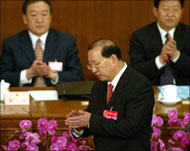China cuts deficit, boosts arms budget
China has announced plans to cut deficit spending, increase the military budget and promote “balanced” growth to narrow the wealth gap between urban and rural regions.

China’s economy, which recorded 9.1% growth last year, was riddled with problems including redundant investment, over-reliance on government spending to boost growth and the neglect of rural areas, planning minister Ma Kai told the annual session of parliament, the National People’s Congress on Saturday.
“While affirming our achievements, we are clearly aware that there are still many difficulties and problems in China’s economic and social development that we cannot afford to ignore,” he said.
The deficit
Recognising the risks of spiralling deficits that have spurred growth, Finance Minister Jin Renqing released a draft budget for 2004 which reduces the budget shortfall to 2.5% of gross domestic product (GDP) from 2.9% for 2003.
The deficit would remain the same as last year, at about 319.8bn yuan ($38.6bn), making 2004 the first year since 1998 it has not grown.
Ma and Jin’s reports followed Prime Minister Wen Jiabao’s pledge to parliament on Friday to focus on helping the millions of farmers across China that are living in poverty.
In a separate speech, Jin said spending needed to be adjusted to develop infrastructure in poor regions.
“In some regions especially in rural areas, people still do not have adequate access to schools, doctors, potable water and transportation,” Jin said.
Revenues
|
“While affirming our achievements, we are clearly aware that Ma Kai |
Total revenues in the draft central and local budgets for 2004 are 2.35 trillion yuan, up 8.7% over 2003, while total
expenditures in the two budgets will reach 2.67 trillion yuan, up 8.8%.
Despite the emphasis on reducing deficit spending, military spending will rise by 21.8bn yuan or 11.6% from 2003, marking a return to double-digit growth seen in most of the past decade.
Last year, defence spending rose by 9.6% over the previous year after rising 17.6% in 2002 and 17.7% in 2001.
Modernising military
China has long said it needs to modernise its 2.5 million-strong military – the world’s largest – to enable it to cope with a trend towards hi-tech warfare.
 |
|
Jin (C) has called for improving |
The boost in military spending also comes at a time of increasing tensions with Taiwan. The island has angered Beijing with plans to hold a referendum on 20 March to seek public approval for the strengthening of its defences against a Chinese military build-up targeting Taiwan, which Beijing sees as part of China.
Taiwan was however not mentioned as a reason for the hike in the military budget, with Jin saying the increase was to improve the “defensive combat readiness of the armed forces under hi-tech conditions”.
No figure for military spending this year was given, but the 2003 budgeted figure was 185.3bn yuan. China’s real military spending, however, is estimated by Western analysts to range from between two and three times that.
Lifting farmers’ income
|
“In some regions especially in rural areas, people still do not have adequate access to schools, doctors, potable water and transportation” Jin Renqing, |
The priority this year will, however, be to boost rural expenditure to lift farmers’ income – a move crucial to increasing consumer spending and maintaining social stability.
Investment in farmers – including education and health services – will be increased in 2004 by more than 30bn yuan, or 20% over last year.
Economically backward western regions will be targeted. China also pledged to boost rural incomes for China’s 900 million farmers by 5.0% in 2004 and eliminate rural taxes within five years. Per capita rural income rose by only 4.3% last year to 2622 yuan ($316), compared to a rise of 9.0% in urban areas.